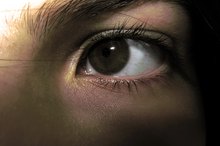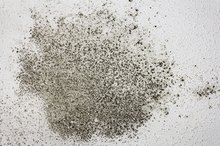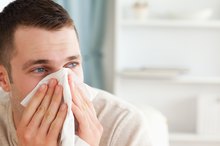What does fact checked mean?
At Healthfully, we strive to deliver objective content that is accurate and up-to-date. Our team periodically reviews articles in order to ensure content quality. The sources cited below consist of evidence from peer-reviewed journals, prominent medical organizations, academic associations, and government data.
The information contained on this site is for informational purposes only, and should not be used as a substitute for the advice of a professional health care provider. Please check with the appropriate physician regarding health questions and concerns. Although we strive to deliver accurate and up-to-date information, no guarantee to that effect is made.
Harmful Side Effects of Black Mold
Black mold, also referred to as mold or mildew, is a type of fungus that produces a fluffy or powdery growth on surfaces 4. Black mold is able to grow on many household surfaces, such as carpets, cloth, leather, wood, insulation and food 4. Exposure to black mold can lead to several health problems, which vary according to the method of contact 34. Symptoms of black mold exposure can be classified into four categories: allergies, irritations, infections and toxicities 4.
If you are experiencing serious medical symptoms, seek emergency treatment immediately.
Allergies
An allergic response is the most common symptom of black mold exposure 4. Individuals who are allergic to black mold may experience sneezing, watery eyes, redness and itching of the skin and headache 4.
Irritations
Black Mold & Eye Problems
Learn More
Irritations due to black mold exposure result when the fungus degrades substances in order to live and in the process produces volatile organic compounds 4. VOCs cause the moldy or mildewy odor associated with the presence of molds. Exposure to VOCs may cause irritation of your mucous membranes and central nervous system. Symptoms associated with this type of exposure may include:
- nosebleeds
- coughing up black-appearing sputum
- constant headaches
- dizziness
- decreased attention span
- difficulty in concentrating
- Irritations due to black mold exposure result when the fungus degrades substances in order to live and in the process produces volatile organic compounds 4.
Infections
Infections due to black mold exposure are extremely rare, but they can occur 4. People with weakened immune systems due to HIV/AIDS or chemotherapy may have an increased susceptibility to infection due to black mold 4. The scientific name for the fungus that causes black mold is Aspergillus niger 4. A lung infection known as aspergillosis may occur if large quantities of Aspergillus niger are inhaled 1. Symptoms associated with apergillosis include fever, coughing up blood and wheezing. In addition, if black mold spores get into that ear canal, a fungal ear infection may occur 4. Symptoms associated with this ear infection include ear pain and temporary hearing loss, and it's possible for the infection to damage the ear canal.
Toxicity
Black Mold & Eye Problems
Learn More
Black mold may also produce a poisonous substance called mycotoxins 4. According to the website BlackToxicMolds.com, black molds do not constantly produce mycotoxins 4. Black molds produce most mycotoxins in areas with constant moisture such as behind wall panels, in ceilings or under carpets 4. Michael Bains' article titled "Black Mold Symptoms" on the website PlanetMold.com states that toxicity can occur when humans contact these mycotoxins either by ingestion or skin contact 4. Black mold toxicity can cause life-altering or life-threatening medical conditions 4. It should be noted that toxicity from black mold exposure is extremely rare and the severity of this condition will differ from person to person 4.
Related Articles
References
- Mayo Clinic: Aspergillosis
- Center for Disease Control and Prevention: Mold
- Toxic Black Mold Info: Health Risks from Toxic Mold
- Black Toxic Molds: Black Toxic Mold
- Bozek A, Pyrkosz K. Immunotherapy of mold allergy: A review. Hum Vaccin Immunother. 2017;13(10):2397-2401. . doi:10.1080/21645515.2017.1314404
- Borchers AT, Chang C, Eric gershwin M. Mold and Human Health: a Reality Check. Clin Rev Allergy Immunol. 2017;52(3):305-322. doi:10.1007/s12016-017-8601-z
- Balmes JR. Chapter 107. Molds. In: Olson KR. eds. Poisoning & Drug Overdose, 6e, New York, NY: McGraw-Hill; 2012.
- Bozek A, Pyrkosz K. Immunotherapy of mold allergy: A review. Hum Vaccin Immunother. 2017;13(10):2397-2401. doi:10.1080/21645515.2017.1314404
- Cipriani F, Calamelli E, Ricci G. Allergen Avoidance in Allergic Asthma. Front Pediatr. 2017;5:103. doi:10.3389/fped.2017.00103
- Chinoy B, Yee E, Bahna SL. Skin testing versus radioallergosorbent testing for indoor allergens. Clin Mol Allergy. 2005; 3:4. Clinic Rev Allerg Immunol (2017) 52:305–322. doi:10.1186/1476-7961-3-4
- Edmondson, DA. Allergy and “toxic mold syndrome.” Ann Allergy Asthma Immunol. 2005 Feb;94(2):234-9. doi:10.1016/S1081-1206(10)61301-4Get
- Coop, CA. Immunotherapy for Mold Allergy. Clinic Rev Allerg Immunol (2014) 47:289–298. doi:10.1007/s12016-013-8389-4
- Centers for Disease Control & Prevention. Mold Prevention Strategies and Possible Health Effects in the Aftermath of Hurricanes and Major Floods. Published June 9, 2006.
Writer Bio
Robert Shifko has more than 17 years' experience in the health care industry. Throughout his career, he has gained experience in pharmacologic research, clinical nuclear medicine, and most recently radiation health physics. He has obtained several certifications in nuclear medicine, epidemiology, biostatistics and as a medical radiation safety officer. He has always supported LIVESTRONG.








